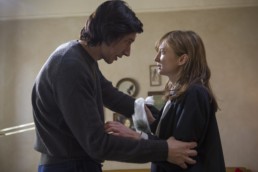‘Hungry Hearts’ Review: An Artfully Composed Italian Drama
This Italian drama isn’t all tragedy and gloom – its artful aesthetic makes it one of the most well-crafted gems of the year.
Considering the opening scene of Hungry Hearts involves a rather comedic and bizarre circumstance involving bowel movements, one might be expecting a bit more of a light-hearted romantic comedy going into this film. This is definitely not the case.
Hungry Hearts is an Italian drama by Saverio Costanzo. Based on the novel “The Indigo Child,” by Marco Franzoso, Adam Driver and Alba Rohrwacher play Jude and Mina, two seemingly likeable newlyweds in love. Soon it is revealed that Mina, who is strangely obsessed with purity and non-traditional medicine, is having complications conceiving a child. Since she doesn’t believe in doctors and thinks their baby is some sacred, mystical ‘indigo child,’ the rest of the film pits husband against wife, as Jude attempts to ensure his son is safe and grows properly. Meanwhile, Mina does everything in her power to keep the child away from modern medicine. Things only escalate from here, folks.
After watching this film, I fear that a large amount of viewers may find Hungry Hearts an unpleasant viewing experience, which may possibly overshadow its artful direction, in a similar vein to movies like Blue Valentine. Though nothing of extreme shock value occurs in this picture and Costanzo isn’t aiming to be inherently provocative, Hungry Hearts is a somewhat tough watch. It is wonderfully rewarding, but nevertheless, a tough watch. Costanzo’s film has an intriguing sense of dread to it, and at times, made me think of the 1981 horror gem Possession, though it never ventures that far into crazy town.
…I fear that a large amount of viewers may find Hungry Hearts an unpleasant viewing experience, which may possibly overshadow its artful direction…
From the very first scene of the film, Constanzo shoots in surprisingly long takes, showcasing two absurdly talented actors who are quite dedicated to their performances here. As far as the cinematography, the film is painfully gorgeous, which isn’t a surprise given that it was shot on 16mm by the incredible Fabio Cianchetti, who shot Bertolucci’s The Dreamers among many other classics. Costanzo’s choice to shoot in cinema verite style proved to be one of the strongest points of the film. There are many scenes where Jude and Mina argue and walk through the house as the shaky handheld camera follows them, and this proves to be so intimate it almost feels intrusive.
While both leads in Hungry Hearts won high awards and praise at the Venice Film Festival for their work, it is Driver who shines as the more endearing character. Though Rohrwacher’s performance was quite heartbreaking, it almost feels cheap how she never has a chance. By the end of the film, she’s quite detestable and there isn’t much wiggle room on that. Indeed, the problem lies within her mental illness, but I felt that the filmmaker was on Jude’s side, which could just be a problem within the source material.
If audiences can see past the overall gloom of this film, they will be rewarded. Hungry Hearts has a unique sense of dread going for it, perhaps capturing a bit of a Polanski vibe throughout. In the end, I thought the director was going to push a bit more of a provocative button, but for the most part, it’s dark and tragic, but never veers into absolute depression mode. Costanzo’s piece will surely be of a divisive nature but it is also one of the most thoroughly well-crafted gems of 2015. Though the film may not end up getting the distribution or praise it deserves, Costanzo’s absolute mastery in directing is not something to be overlooked.
Hungry Hearts opens this Friday, June 12th, at the Sundance Sunset Cinema.


